County Antrim
County Antrim
| |
|---|---|
| Nickname: TheGlensCounty | |
| Motto(s): Per angusta ad augusta(Latin) "Through Trial to Triumphs" | |
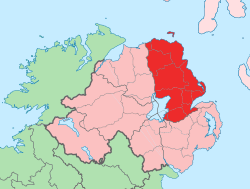 | |
| Coordinates:54°51′54″N6°16′48″W/ 54.865°N 6.280°W | |
| Country | United Kingdom |
| Region | Northern Ireland |
| Province | Ulster |
| Established | c. 1400 |
| County town | Antrim |
| Area | |
| • Total | 1,192 sq mi (3,086 km2) |
| • Rank | 9th |
| Highest elevation (Trostan) | 1,808 ft (551 m) |
| Population (2021) | 651,321 |
| • Rank | 2nd |
| Time zone | UTC±0(GMT) |
| • Summer (DST) | UTC+1(BST) |
| Postcode area | |
| Contae Aontromais the Irish name;Coontie Antrìm,[2]Countie Antrim,[3]Coontie Anthrim[4]andCoonty Entrim[5]areUlster-Scotsnames. | |
County Antrim(named after the town ofAntrim,fromIrishAontroim,meaning 'lone ridge')[6]is one of the sixcounties of Northern Ireland,located within the historicprovinceofUlster.Adjoined to the north-east shore ofLough Neagh,the county covers an area of 3,086 square kilometres (1,192 sq mi) and has a population of 651,321,[7]as of the2021 census.County Antrim has a population density of 211 people per square kilometre or 546 people per square mile.[8]It is also one of the thirty-two traditionalcountiesofIreland.
TheGlens of Antrimoffer isolated rugged landscapes, theGiant's Causewayis a unique landscape and a UNESCOWorld Heritage Site,Bushmillsproduces whiskey, andPortrushis a popular seaside resort and night-life area. The majority ofBelfast,the capital city of Northern Ireland, is in County Antrim, with the remainder being inCounty Down.
According to the2001,2011,and2021 censusesit is currently one of only two counties of the Island of Ireland in which a plurality or majority of the population are from aProtestantbackground. The other isCounty Downto the south.
Geography
[edit]
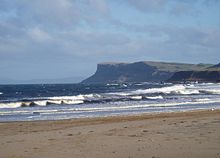

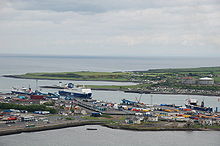
A large portion of Antrim is hilly, especially in the east, where the highest elevations are attained. The range runs north and south, and, following this direction, the highest points are Knocklayd 514 m (1,690 ft),Slieveanorra508 m (1,670 ft),Trostan550 m (1,800 ft),Slemish437 m (1,430 ft), Agnew's Hill 474 m (1,560 ft) andDivis478 m (1,570 ft).[9]The inland slope is gradual, but on the northern shore the range terminates in abrupt and almost perpendicular declivities, and here, consequently, some of the finest coast scenery in the world is found, widely differing, with its unbroken lines of cliffs, from the indented coast-line of the west. The most remarkable cliffs are those formed of perpendicular basaltic columns, extending for many miles, and most strikingly displayed inFair Headand the celebratedGiant's Causeway.From the eastern coast the hills rise instantly but less abruptly, and the indentations are wider and deeper. On both coasts there are several resort towns, includingPortrush(with well-known golf links),PortballintraeandBallycastle;on the eastCushendun,CushendallandWaterfooton Red Bay,CarnloughandGlenarm,Larneon theSea of Moyle,andWhiteheadon Belfast Lough. All are somewhat exposed to the easterly winds prevalent in spring. The only island of size is the L-shapedRathlin Island,off Ballycastle, 11 km (6.8 mi) in total length by 2 km (1.2 mi) maximum breadth, 7 km (4.3 mi) from the coast, and of similar basaltic and limestone formation to that of the mainland. It is partially arable, and supports a small population.Islandmageeis a peninsula separatingLarne Loughfrom theNorth Channel.[10]
The valleys of theBannandLagan,with the intervening shores ofLough Neagh,form the fertile lowlands. These two rivers, both rising in County Down, are the only ones of importance. The latter flows to Belfast Lough, the former drains Lough Neagh, which is fed by a number of smaller streams. The fisheries of the Bann and of Lough Neagh (especially forsalmonandeels) are of value both commercially and to sportsmen, the small town ofToome,at the outflow of the river, being the centre. Immediately below this point liesLough Beg,the "Small Lake", about 4.5 m (15 ft) lower than Lough Neagh.[10]
Transport
[edit]County Antrim has a number of air, rail and sea links.
Airports
[edit]Northern Ireland's main airport, Belfast International Airport, at Aldergrove, is in County Antrim. Belfast International shares its runways with38 Brigade Flying Station Aldergrove,which otherwise has its own facilities.[11]It is the fifth-largest regional air cargo centre in the UK. There are regular services to Great Britain, Europe and North America.
The region is also served byGeorge Best Belfast City Airport,a mile east ofBelfast city centreon the County Down side of the city, which was renamed in 2006 in honour offootballerGeorge Best.
Rail
[edit]
The mainTranslinkNorthern Ireland Railwaysroutes are the major line between Belfast, Antrim,Ballymena,ColeraineandDerry,Belfast toCarrickfergusandLarne,the port forStranraerin Scotland and Coleraine toPortrush.
Sea
[edit]Two of Northern Ireland's main ports are in County Antrim,LarneandBelfast.
Ferries sail from Larne Harbour to destinations includingCairnryanin Scotland.
ThePort of Belfastis Northern Ireland's principal maritime gateway, serving the Northern Ireland economy and increasingly that of theRepublic of Ireland.It is a major centre of industry and commerce and has become established as the focus of logistics activity for Northern Ireland. Around two-thirds of Northern Ireland's seaborne trade, and a quarter of that for Ireland as a whole is handled at the port, which receives over 6,000 vessels each year.[12]
Demographics
[edit]As of the2021 census,County Antrim had a population of 651,321,[13]making it the most populous county in Northern Ireland, and the second-largest county by population on theisland of Ireland,second only toCounty Dublin.
Ethnicity
[edit]| Ethnic Group | Number | (%) |
|---|---|---|
| White:Total | 623,574 | 95.74 |
| White | 622,011 | 95.50 |
| White: British/Irish/Northern Irish/English/Scottish/Welsh (with or without non-UK or Irish national identities) |
600,912 | 92.26 |
| White:Other | 21,099 | 3.24 |
| White:Irish Traveller | 569 | 0.09 |
| White:Roma | 994 | 0.15 |
| AsianorAsian British:Total | 16,533 | 2.54 |
| Asian/Asian British:Indian | 5,406 | 0.83 |
| Asian/Asian British:Chinese | 5,149 | 0.79 |
| Asian/Asian British:Filipino | 2,221 | 0.34 |
| Asian/Asian British:Arab | 1,114 | 0.17 |
| Asian/Asian British:Pakistani | 687 | 0.11 |
| Asian/Asian British: Other Asian | 1,956 | 0.30 |
| BlackorBlack British:Total | 4,614 | 0.71 |
| Black/Black British:Black African | 3,961 | 0.61 |
| Black/Black British: Black Other | 653 | 0.10 |
| Mixed:Total | 5,253 | 0.81 |
| Other: Any other ethnic group: Total | 1,347 | 0.21 |
| Total | 651,321 | 100.00 |
Country of birth
[edit]| Country of birth | Number | (%) |
|---|---|---|
| United Kingdom and Ireland | 605,844 | 93.02 |
| Northern Ireland | 565,951 | 86.89 |
| England | 24,451 | 3.75 |
| Scotland | 6,010 | 0.92 |
| Wales | 936 | 0.14 |
| Republic of Ireland | 8,496 | 1.30 |
| Europe | 21,643 | 3.32 |
| European Union | 20,400 | 3.13 |
| Other non-EU countries | 1,243 | 0.19 |
| Rest of World | 23,833 | 3.66 |
| Middle EastandAsia | 14,325 | 2.20 |
| Africa | 4,951 | 0.76 |
| North America,Central AmericaandCaribbean | 2,885 | 0.44 |
| Antarctica,Oceaniaand Other | 1,061 | 0.16 |
| South America | 611 | 0.09 |
| Total | 651,321 | 100.00 |
Community background and religion
[edit]A traditionally Protestant-majority county since thePlantation of Ulsterby Scottish and English settlers, the 2021 census revealed that those of a Protestant and Other Christian community background were no longer a majority in Antrim, comprising 47.0% of the population,[17]a sharp decline from 75.2% in 1861.[18]This is largely attributable to the rapid increase of the Catholic population, particularly in the city of Belfast, where they now comprise a plurality of the population, and its surroundingmetropolitan area,as well asimmigrationfrom other parts of the world following the end ofThe Troublesand increasing rates of irreligion.
| Religion or religion brought up in | Number | (%) |
|---|---|---|
| Protestant and Other Christian | 306,335 | 47.03 |
| Catholic | 260,867 | 40.06 |
| None (no religion) | 70,629 | 10.84 |
| Other religion | 13,490 | 2.07 |
| Total | 651,321 | 100.00 |
| Religion | Number | (%) |
|---|---|---|
| Christian | 498,196 | 76.49 |
| Catholic | 237,034 | 36.39 |
| Presbyterian | 127,230 | 19.53 |
| Church of Ireland | 66,990 | 10.29 |
| Methodist | 18,286 | 2.81 |
| Other Christian (including Christian related) | 48,656 | 7.47 |
| Protestant and Other Christian: Total | 261,162 | 40.10 |
| Other religions | 12,049 | 1.85 |
| None/not stated | 141,076 | 21.66 |
| No religion | 129,016 | 19.81 |
| Religion not stated | 12,060 | 1.85 |
| Total | 651,321 | 100.00 |
National identity
[edit]| National identity | Number | % |
|---|---|---|
| British only | 230,873 | 35.45% |
| Irish only | 167,425 | 25.71% |
| Northern Irish only | 121,867 | 18.71% |
| British and Northern Irish only | 57,822 | 8.88% |
| Irish and Northern Irish only | 10,341 | 1.59% |
| British, Irish and Northern Irish only | 9,673 | 1.49% |
| British and Irish only | 4,142 | 0.64% |
| Other identity | 49,178 | 7.55% |
| Total | 651,321 | 100.00% |
| All Irish identities | 193,538 | 29.72% |
| All British identities | 308,548 | 47.37% |
| All Northern Irish identities | 202,615 | 31.11% |
Irish language and Ulster Scots
[edit]In the 2021 UK census in County Antrim:
- 12.77% claim to have some knowledge of the Irish language, whilst 3.64% claim to be able to speak, read, write and understand spoken Irish. 2.55% claim to use Irish daily. 0.46% claim that Irish is their main language.
- 12.09% claim to have some knowledge of Ulster Scots, whilst 1.39% claim to be able to speak, read, write and understand spoken Ulster Scots. 2.25% claim to use Ulster Scots daily.
Statistics for 2009–2010 show 1,832 students attending the twelveGaelscoileanna(Irish language primary schools) and oneGaelcholáiste(Irish language secondary school).[24]
Administration
[edit]The county was administered byAntrim County Councilfrom 1899 until the abolition of county councils in Northern Ireland in 1973.[25]The traditional county town isAntrim.More recently,Ballymenawas the seat of county government. From 1973 Northern Ireland was split intodistricts,which were redrawn in 2015. County Antrim is part of the following districts:
- Antrim and Newtownabbey
- Belfast
- Causeway Coast and Glens
- Mid and East Antrim
- Lisburn and Castlereagh
- Armagh City, Banbridge and Craigavon
The county contains within it the whole of fiveparliamentaryconstituencies:
Parts of the following fiveparliamentaryconstituenciesare also in County Antrim:
Settlements
[edit]Cities
[edit]Places with official city status:
Large towns
[edit](population of 18,000 or more and under 75,000 at 2001 Census)[26]
Medium towns
[edit](population of 10,000 or more and under 18,000 at 2001 Census)[26]
- none
Small towns
[edit]
(Population of 4,500 or more and under 10,000 at 2001 Census)[26]
Intermediate settlements
[edit](population of 2,250 or more and under 4,500 at 2001 Census)[26]
Villages
[edit]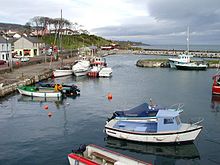
(Population of 1,000 or more and under 2,250 at 2001 Census)[26]
- Bushmills
- Carnlough
- Cloughmills
- Cogry & Kilbride
- Cushendall
- Doagh
- Dunloy
- Glenavy
- Kells
- Portglenone
- Templepatrick
Small villages or hamlets
[edit](population of less than 1,000 at 2001 Census)[26]
- Aghagallon
- Aghalee
- Aldergrove
- Armoy
- Ballintoy
- Ballycarry
- Ballyeaston
- Ballygalley
- Ballynure
- Boneybefore
- Cairncastle
- Carnalbanagh
- Cargan
- Cushendun
- Dervock
- Glenarm
- Glynn
- Loughguile
- Moss-Side
- Newtown Crommelin
- Parkgate
- Portballintrae
- Rasharkin
- Stranocum
- Toome
Subdivisions
[edit]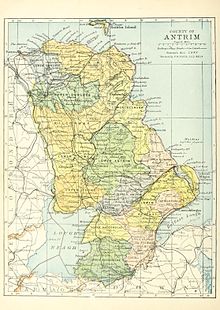

Baronies
Parishes
Townlands
History
[edit]
At what date the county of Antrim was formed is not known, but it appears that a certain district bore this name before the reign ofEdward II(early 14th century), and when the shiring of Ulster was undertaken by SirJohn Perrotin the 16th century, Antrim and Down were already recognised divisions, in contradistinction to the remainder of the province. The earliest known inhabitants wereMesolithichunter-gatherersof pre-Celticorigin,[27]but the names of thetownlandsor subdivisions, supposed to have been made in the 13th century, are all of Celtic derivation.[10]
In ancient times, Antrim was inhabited by a Celtic people called theDarini.[28]In the early Middle Ages, southern County Antrim was part of the Kingdom ofUlidia,ruled by theDál Fiatachclans Keenan and MacDonlevy/McDunlavey; the north was part ofDál Riada,which stretched into what is now western Scotland over the Irish Sea. Dál Riada was ruled by the O'Lynch clan, who werevassalsof the Ulidians. Besides the Ulidians and Dál Riada, there were theDál nAraideof lower County Antrim, and theCruthin,who were pre-Gaelic Celts and probably related to the Picts of Britain.[29]Between the 8th and 11th centuries Antrim was exposed to the inroads of theVikings.[10]
In the late 12th century Antrim became part of theEarldom of Ulster,conquered byAnglo-Normaninvaders. A revival of Gaelic power followed the campaign ofEdward Brucein 1315, leavingCarrickfergusas the only significant English stronghold. In the late Middle Ages, Antrim was divided into three parts: northern Clandeboye, the Glynnes and the Route. TheCambro-NormanMacQuillanswere powerful in the Route.
A branch of the O'Neills of Tirconnell (modern Tyrone) migrated to Clandeboye in the 14th century, and ruled it for a time from their castle on Lough Neagh. Their family was called Clandeboye O'Neills. Donald Balloch, who succeeded his father John Mor Macdonald, Lord of Dunyvaig and the Glens, married the daughter of Conn O'Neill of the Clandeboye O'Neills sometime after the Battle of Inverlochy. In 1433, Alexander of Islay, Lord of the Isles, joined with his cousin, Donald Balloch, Conn O'Neill of the Clandeboye O'Neills, and Eoghan O'Neill, king of Tirowen (modern Tyrone) to defend against an attack on Antrim by the O'Donnells of Tirconnell. Alexander Macdonald led the attack that was successful, so that the O'Donnells became subject to the O'Neills of Tirowen.[30]AGallowglasssept, the MacDonnells (they were "Macdonalds" in Scotland), became the most powerful in the Glens in the 15th century.
During theTudor era(16th century) numerous adventurers from Britain attempted to colonise the region; many Scots settled in Antrim around this time.[31]In 1588 the Antrim coast was the scene of one of the 24 wrecks of theSpanish Armada in Ireland.The Spanish vesselLa Gironawas wrecked off Lacana Point, Giant's Causeway in 1588 with the loss of nearly 1,300 lives.[32]
Antrim is divided into sixteen baronies. Lower Antrim, part of Lower Clandeboye, was settled by the sept O'Flynn/O'Lynn. Upper Antrim, part of Lower Clandeboye, was the home of the O'Keevans. Belfast was part of Lower Clandeboye and was held by the O'Neill-Clannaboys. Lower Belfast, Upper Belfast, and Carrickfergus were also part of Lower Clandeboye. Cary was part of the Glynnes; ruled originally by the O'Quinn sept, the MacDonnell galloglasses from Scotland took power here in the late Middle Ages and some of the O'Haras also migrated fromConnaught.Upper and LowerDunlucewere part of the Route, and were ruled by the MacQuillans. Upper and LowerGlenarmwas ruled by the O'Flynn/O'Lynn sept, considered part of the Glynns. In addition to that sept and that of O'Quinn, both of which were native, the ScottishGallowglasssepts of MacKeown, MacAlister, and MacGee, are found there. Kilconway was originally O'Flynn/O'Lynn territory, but was held by the MacQuillans as part of the Route, and later by thegallowglasssept of MacNeill. Lower Massereene was part of Lower Clandeboye and was ruled by the O'Flynns and the O'Heircs. Upper Massereene was part of Lower Clandeboye, ruled by the O'Heircs. Upper and Lower Toome, part of the Route, were O'Flynn/O'Lynn territory. Misc was first ruled by the MacQuillans. Later, the Scottish Gallowglass MacDonnells and MacAlisters invaded. The MacDonnells were a branch of the Scottish Clan MacDonald; the MacAlisters traced their origin back to the Irish Colla Uais, eldest of the Three Collas.
Islandmageehad, besides antiquarian remains, a notoriety as a home of witchcraft, and during theIrish Rebellion of 1641was the scene of an act of reprisal (for the massacre ofProtestants) against the Catholic population by the ScottishCovenantersoldiery ofCarrickfergus.[10]
In 1689 during theWilliamite War in Ireland,County Antrim was a centre of Protestant resistance against the rule of the CatholicJames II.During the developing crisis James' garrison atCarrickfergussuccessfully repulsed an attempt by local Protestants to storm it. After the advance of theIrish ArmyunderRichard Hamilton,all of County Antrim was brought underJacobitecontrol. Later in the year a major expedition from England underMarshal Schomberglanded inBelfast Loughand successfullylaid siege to Carrickfergus.Having captured most of the largest towns of the area, they then marched southwards towardsDundalk.
Historic monuments
[edit]

The antiquities of the county consist ofcairns,mounts or forts, remains of ecclesiastical and military structures, andround towers.
There are three round towers: one at Antrim, one atArmoy,and one onRam's Islandin Lough Neagh, only that at Antrim being perfect. There are some remains of the ecclesiastic establishments atBonamargy,where the earls of Antrim are buried,Kells,Glenarm,Glynn,Muckamoreand Whiteabbey.[10]
The castle atCarrickfergus,dating from theNorman invasion of Ireland,is one of the best preserved medieval structures in Ireland. There are, however, remains of other ancient castles, asOlderfleet,Cam's,Shane's,Glenarm, Garron Tower, Red Bay,[10]andDunluce Castle,notable for its dramatic location on a rocky outcrop.
The principal cairns are: one on Colin mountain, near Lisburn; one onSlieve True,near Carrickfergus; and two on Colinward. Thecromlechsmost worthy of notice are: one nearCairngrainey,to the north-east of the old road from Belfast toTemplepatrick;the large cromlech at Mount Druid, nearBallintoy;and one at the northern extremity of Islandmagee. The mounts, forts and entrenchments are very numerous.[10]
The natural rock formations ofGiant's Causewayon the Antrim coast are now designated aUNESCOWorld Heritage Site.
Saint Patrick
[edit]Slemish,about eight miles (13 km) east of Ballymena, is notable as being the scene of St Patrick's early life.[10]According to traditionSaint Patrickwas a slave for seven years, near the hill of Slemish, until he escaped back to Great Britain.
Linen
[edit]Linenmanufacturing was previously an important industry in the county. At the time Ireland produced a large amount offlax.Cotton-spinning byjennieswas first introduced to Belfast by industrialists Robert Joy and Thomas M'Cabe in 1777; and twenty-three years later it was estimated that more than 27,000 people were employed in the industry within ten miles (16 km) of Belfast. Women were employed in the working of patterns onmuslin.
Notable residents
[edit]This articleneeds additional citations forverification.(August 2020) |
- James Adair(1709–1783), explorer, trader, and historian[33]
- John Bodkin Adams(1899–1983), general practitioner born inRandalstownand suspected of killing 163 patients while practising in England[34]
- William Aiken(1779–1831), founder ofSouth Carolina Canal and Rail Road Company
- Wayne Boyd(born 1990), racing driver
- Hugh Boyle(1897–1986), fromDunloy,Catholic Bishop of Port Elizabeth and of Johannesburg
- Joey Dunlop(1952–2000), fromBallymoney,five-time World Motorcycle Champion
- Caroline Girvan(born 1984), fitness trainer andYouTuber[35]
- William Magee Hunter(1834–1868), New Zealand soldier, born in County Antrim[36]
- Sir John Jamison(1776–1844), physician andnaval surgeonfromCarrickferguswho became a constitutional reformer inNew South Wales,Australia
- George Macartney, 1st Earl Macartney(1737–1806), fromBallymoney,first British Ambassador to China
- Tony McCoy(born 1974), from Moneyglass, jockey
- Eva McGown(1883–1972), chorister, pioneer, and hostess in Alaska
- John O'Kane Murray(1847–1885), physician and author[33]
- Liam Neeson(born 1952), from Ballymena, actor
- James Nesbitt(born 1965), fromBroughshane,lived nearColeraine,actor
- Josh Rock(born 2001), darts player
- GeneralSir James Steele(1894–1975), seniorBritish Armyofficer who served in bothWorld War IandWorld War II
- Geoff Wylie(born 1956), from Ballymena, darts player
Flora and fauna
[edit]Records of theseaweedsof County Antrim were brought together and published in 1907 by J. Adams[37]who notes that the list contains 211 species. Batter's list, of 1902,[38]contained 747 species in his catalogue of British marine algae.
Of the freshwateralgaethere are 10 taxa in theCharophyta(Charales) recorded from County Antrim:Chara asperavar.aspera;Chara globularisvar.globularis;Chara globularisvar.virgata(Kütz.) R.D.;Chara vulgarisvar.vulgaris;Chara vulgarisvar.contraria(A. Braun ex Kütz.) J.A.Moore;Chara vulgarisvar.longibracteata(Kütz.) J. Groves & Bullock-Webster;Chara vulgarisvar.papillataWallr. ex A. Braun;Nitella flexilisvar.flexilis;Nitella translucens(Pers.) C.A. Ag. andTolypella nidificavar.glomerata(Desv.) R.D. Wood.[39]
Sport
[edit]See also
[edit]- Abbeys and priories in Northern Ireland (County Antrim)
- List of townlands in County Antrim
- List of civil parishes of County Antrim
- Lord Lieutenant of Antrim
- High Sheriff of Antrim
References
[edit]- ^Northern Ireland General Register Office (1975). "Table 1: Area, Buildings for Habitation and Population, 1971".Census of Population 1971; Summary Tables(PDF).Belfast: HMSO. p. 1.Archived(PDF)from the original on 23 July 2019.Retrieved28 August2019.
- ^Bonamargy Friary GuideArchived30 August 2011 at theWayback MachineDepartment of the Environment.
- ^North-South Ministerial Council: 2004 Annual Report in Ulster ScotsArchived2 September 2012 at theWayback Machine
- ^2008 annual report in Ulster-ScotsArchived3 July 2013 at theWayback MachineTourism Ireland.
- ^The Ulster-Scot,June 2011Archived1 September 2011 at theWayback MachineCharlie 'Tha Poocher' Rennals.
- ^Postal Towns/Bailte PoistArchived7 February 2012 at theWayback Machine,Northern Ireland Place-name Project.Queen's University Belfast.Retrieved 8 March 2012.
- ^"Get data for your table | NISRA Flexible Table Builder".build.nisra.gov.uk.Archivedfrom the original on 19 July 2023.Retrieved19 July2023.
- ^Divide the population of County Antrim (618,108) by the area (3086 km2)
- ^"Mountain Views".Simon Stewart.Archivedfrom the original on 11 November 2011.Retrieved30 August2010.
- ^abcdefghiOne or more of the preceding sentences incorporates text from a publication now in thepublic domain:Chisholm, Hugh,ed. (1911). "Antrim (county)".Encyclopædia Britannica.Vol. 2 (11th ed.). Cambridge University Press. pp. 152–154.
- ^"VATSIM UK | Home".www.vatsim.uk.Archivedfrom the original on 2 July 2022.Retrieved10 June2022.
- ^"About Us".Belfast Harbour.Archived fromthe originalon 29 May 2007.
- ^"Get data for your table | NISRA Flexible Table Builder".build.nisra.gov.uk.Archivedfrom the original on 19 July 2023.Retrieved19 July2023.
- ^"Get data for Ethnic group (MS-B01) | NISRA Flexible Table Builder".build.nisra.gov.uk.Archivedfrom the original on 19 July 2023.Retrieved19 July2023.
- ^"Get data for your table | NISRA Flexible Table Builder".build.nisra.gov.uk.Archivedfrom the original on 19 July 2023.Retrieved19 July2023.
- ^"Get data for Country of birth - basic detail (MS-A16) | NISRA Flexible Table Builder".build.nisra.gov.uk.Archivedfrom the original on 19 July 2023.Retrieved19 July2023.
- ^ab"Get data for Religion or religion brought up in (MS-B23) | NISRA Flexible Table Builder".build.nisra.gov.uk.Archivedfrom the original on 19 July 2023.Retrieved19 July2023.
- ^"Changing Distribution of Protestants in Ireland 1861 - 1991".www.wesleyjohnston.com.Archivedfrom the original on 27 March 2023.Retrieved19 July2023.
- ^"Get data for Religion (MS-B19) | NISRA Flexible Table Builder".build.nisra.gov.uk.Archivedfrom the original on 19 July 2023.Retrieved19 July2023.
- ^"Get data for National identity (person based) - basic detail (classification 1) (MS-B15) | NISRA Flexible Table Builder".build.nisra.gov.uk.Archivedfrom the original on 19 July 2023.Retrieved19 July2023.
- ^"National Identity (Irish)".NISRA.Archivedfrom the original on 18 August 2023.Retrieved18 August2023.
- ^"National Identity (British)".NISRA.Archivedfrom the original on 18 August 2023.Retrieved18 August2023.
- ^"National Identity (Northern Irish)".NISRA.Archivedfrom the original on 18 August 2023.Retrieved18 August2023.
- ^"Statistics from the national Gaelscoil management body".Archivedfrom the original on 24 August 2012.Retrieved9 January2012.
- ^"Local Government Act (Northern Ireland) 1972".Legislation.gov.uk.Archivedfrom the original on 30 October 2019.Retrieved29 November2019.
- ^abcdef"Statistical classification of settlements".NI Neighbourhood Information Service.Archivedfrom the original on 17 February 2010.Retrieved23 February2009.
- ^Waddell, John (1998).The Prehistoric Archaeology of Ireland.Galway: Galway University Press Limited. pp. 11–24.
- ^O'Rahilly, Thomas F.(1946).Early Irish History and Mythology.Dublin: Dublin Institute for Advanced Studies. p. 7.
- ^O'Rahilly, Thomas F.(1946).Early Irish History and Mythology.Dublin: Dublin Institute for Advanced Studies. pp. 341–352.
- ^Egan, S. (2018)The Early Stewart Kings, the Lordship of the Isles, and Ireland,c.1371-c.1433. Northern Studies, 49, pp. 61-78.
- ^Benn, George(1877).A History of the Town of Belfast.Belfast: Marcus Ward & Company. pp.21ff.;Encyclopædia Britannica(14th edition),Antrim.
- ^"La Girona"(PDF).# Annual Report of the Advisory Committee on Historic Wrecks, 2005.Advisory Committee on Historic Wreck Sites. p. 35.Archived(PDF)from the original on 14 January 2007.Retrieved1 November2008.
- ^abWho Was Who in America, Historical Volume, 1607–1896.Chicago: Marquis Who's Who. 1967.
- ^Cullen, Pamela V., "A Stranger in Blood: The Case Files on Dr John Bodkin Adams", London, Elliott & Thompson, 2006,ISBN1-904027-19-9
- ^Beecroft, Jade (9 January 2021)."Northern Ireland mum becomes internet sensation with home workouts".Belfast Telegraph.Retrieved15 July2024.
- ^Taonga, New Zealand Ministry for Culture and Heritage Te Manatu."Hunter, William Magee".teara.govt.nz.Archivedfrom the original on 30 January 2023.Retrieved30 January2023.
- ^Adams, J.1907. The Seaweeds of the Antrim Coast.Scient. Pap. Ulster Fish. Biol. Ass.Vol.1: 29 – 37
- ^Batters, E.A.L.1902. A catalogue of the British marine algae being a list of all the species of seaweed known to occur on the shores of the British Islands, with the localities where they are found.J. Bot., Lond.40(suppl.): (2) + 107.
- ^Hackney, P. ed.Stewart & Corry's Flora of the North-east of Ireland.Third edition Institute of Irish Studies and The Queen's University of Belfast.ISBN0 85389 446 9



